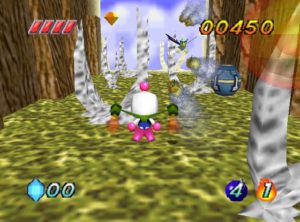
Let’s talk about Bomberman. Introduced in 1983, the Bomberman series has established itself as one of the iconic franchises of gaming, and for good reason. Nearly every system under the sun has at least one entry in the franchise. Moreover, the series has garnered a reputation for its simple, fast-paced, top-down puzzle gameplay and is best known for its frantic multiplayer mayhem.
Bomberman Hero is a single-player, third-person, action platformer. Developed and published by the now defunct Hudson Soft, the game was released for the N64 in 1998. As with any departure from formula, fans are split on whether or not this game is any good. So why the out-of-left field platformer game? Well, as it turns out, Bomberman Hero was originally planned to be a Bonk game.
As with any departure from formula, fans are split on whether or not this game is any good.
You know, Bonk the Caveman? Anyone? No? Well, now you see why they decided to go with Bomberman instead. Point is, the Bonk series were platformers, so this game’s a platformer.
I rented this game several times as a kid, and I remember having mixed feelings about it. On one hand, I greatly appreciated the fact that—unlike Bomberman 64—I could jump freely, a hang-up I developed from my mostly platformer diet at the time. On the other hand, I remember the game feeling cryptic, alien, and everything in the game’s environments feeling just a bit off. It was both fascinating and a little off-putting.
I actually made it pretty far in, though, which was unusual for me back then as I usually stuck to the first few levels of games. Unfortunately, I never could quite beat it, getting stuck on the boss of the penultimate world. I never forgot about it, though. For whatever reason, this game stuck around in the back of my mind since my childhood. Then, just a few months ago, I stumbled across it in my town’s GameXchange for a mere ten dollars.
Ten bucks for closure? Heck yeah!
Plot
The story begins with Princess Millian and her robot companion, Pibot, escaping their home world, Primus Star. The Garaden Empire, who have recently invaded Primus Star, are hot on their heels. Turns out the princess has stolen a data disk that contains information on…something important, I’m sure, and the empire wants it back. She gets captured, but before that gives Pibot the disk and instructs him to seek the aid of Bomberman.
So it’s basically Star Wars. Yeah, I take issue with this. Not so much that their referencing something popular, or even outright copying it in places. It’s just that everyone parodies Star Wars. Basing a plot on Star Wars isn’t just plagiarism, it’s clichéd plagiarism! In the end, I suppose it’s ultimately harmless. No one’s going to play this game for its story anyway, and besides, who doesn’t love Star Wars?
Basing a plot on Star Wars isn’t just plagiarism, it’s clichéd plagiarism!
Where was I? Oh right. Pibot’s ship crash lands, leading Bomberman to go investigate and learn about the Garaden Empire’s activities. From there, Bomberman and Pibot travel from planet to planet trying to rescue Princess Millian, only for her to be whisked away by the empire at the last second. Rinse and repeat a la Super Mario Bros.

Presentation
In regards to models and textures, the game is on par with most games of the era, and the simplistic nature of Bomberman’s design works well with the graphical limitations. The environments convey the intended mood quite well for the most part, but rarely have much in terms of personality.
The real issues are technical. The game’s frame-rate dips often, especially when there’s multiple explosions on screen, which, considering this is Bomberman we’re talking about, is often. Pop-in is also a noticeable issue for levels set along the Z-axis. Such levels aren’t terribly common, however, as most of the level design is either horizontal or vertical.
The music is a whole other story. The soundtrack, composed by longtime Bomberman series composer Jun Chikuma, is probably my favorite part of this game! The drum and bass inspired soundtrack gives this game a very distinct musical identity. Moreover, the otherworldly sound of Bomberman Hero‘s music fits perfectly with the game’s many alien worlds and bizarre environments. My only complaint is the song selection itself is pretty slim, and of the few songs some get used way more often than others. I really hope you like the song “Redial” because you’re going to be hearing that one a lot (also, I can’t be friends with you if you don’t).
The soundtrack is probably my favorite part of this game!
Between the soundtrack and the bizarre enemy designs, my initial impression that this game was weird was spot on. I’m surprised, too. Usually when I remember a game feeling surreal or mysterious, it’s just a product of my youthful imagination and inexperience; once I revisit it as an adult, it loses that mystique and intrigue. Nope, this game definitely retains that “fever dream” flavor after all these years.
Gameplay
As stated before, Bomberman Hero is a third-person 3D platformer. Bomberman can run, jump, throw bombs, drop bombs, and kick bombs. It took awhile for me to get used to Bomberman’s controls: he not only moved faster than I expected, but felt very heavy. In retrospect, it’s not that Bomberman carries much weight, it’s that he has weight to begin with. Yep, Bomberman has just a little inertia when he moves, which actually feels really good when you get the hang of it. By the end of the game, I was using Bomberman’s momentum to do cool stuff like jump in one direction while chucking bombs in another.

Another unexpected but welcome aspect of the game is its level design. Instead of huge sprawling sandboxes for the player to navigate, the stages are typically linear and fairly constrained, being concise and usually only requiring the player to move in one direction: forward, up, right, etc. Again, I think this works well. Each stage is bite sized and rarely overstays its welcome.
That is until you reach a vehicle stage. Bomberman Hero features four vehicles-like pieces of equipment for Bomberman to use: a jet-pack, a submarine, a helicopter, and an underutilized snowboard. While I like the helicopter alright, I don’t think too highly of the rest. They just feel awkward and a little out of place. To make things worse, the B button no longer attacks and is instead used to maneuver each vehicle in some way, which tripped me up on numerous occasions. While I can appreciate the variety they offer, these segments were a chore compared to the core gameplay.

Unfortunately, my grievances with this game’s design don’t stop at the vehicle stages. This game is very fond of “gotchas”. There are plenty of traps that only seem to exist to stick it to first time players, such as missiles that launch out of destroyed crates. Of course, traps aren’t a problem for cautious players who take their time to look before they leap.
There are plenty of traps that only seem to exist to stick it to first time players.
The real problem is it’s not always possible to look before you leap. The game’s camera mostly stays in a fixed position relative to Bomberman: angle and distance. Because the player’s view is so constrained, seeing what’s to the left or right or above and below is difficult. Remember how I mentioned most levels aren’t set along the Z-axis? That’s great if you want to hide the technical limitations of the game’s engine, but it leads to several situations where enemies can fire at the player before he can even see them. The game does offer some very limited camera controls: the player can rotate the camera by pressing the up, left, and right C buttons…but only while standing still. Seriously, why not just have the camera stay angled the way the player tells it to be until told otherwise?
While we’re on the subject of the game’s camera, boss battles are the one time the camera doesn’t stay in a fixed position. To the game’s credit, it tries to always keep Bomberman and the boss in the frame; the key word here is tries. For whatever reason, the camera is rather lethargic, not wanting to exceed a certain speed of rotation. That said, it works most of the time, with the constant motion only being a little disorientating. When it does screw up, however, you’ll be fighting the camera more than the boss.
At times, you’ll be fighting the camera more than the bosses.
Ending
So after traversing four planets, Bomberman finally catches up with Princess Millian. She asks Bomberman to return the disk that he apparently obtained from Pibot and was carrying this whole time. Bomberman obliges only to find out the Millian he’s talking to isn’t the real Millian and you totally saw that coming didn’t you? Well, the bad guys take the disk and use it to revive their leader, Bagular…whoever that is. Cue one more world, a boss rush, and kicking Bagular’s butt. The game ends with the princess giving Bomberman a medal and a “thank you” kiss while Pibot expresses envy.
Well that was underwhelming…If I didn’t know any better, I’d say there was some sort of secret, unlockable, true ending…
Wait, there is? Okay, now we’re talking! What do I have to do? Find all of the collectible bonus items…and get a perfect score on every level of the game?
To YouTube!
In all seriousness, it’s only worth your time if you really like the game and have the time to 100% it. The true ending amounts to nothing but a non-sequiter plot twist that extends the game by a scant three levels, one of which is a…jetpack stage. While the ending cinematic for beating the true final boss is slightly cooler, it doesn’t add anything to the overall narrative.
In the end, Bomberman Hero is great platformer that feels distinct from its contemporaries. The game’s by no means perfect, but most of the issues it has were more the result of the time it was made than poor design choices on the developers’ part, most notably the camera. Aside from the vehicle stages, the game feels very focused, with its tight controls and concise level design. In my debatably humble opinion, this is a game that deserves a spot in any N64 collector’s library.
I’m really glad I shelled out those ten dollars: finally having closure on this bizarre blast from my past is more than enough bang for my buck.

